2020 HYUNDAI NEXO ECO mode
[x] Cancel search: ECO modePage 405 of 561
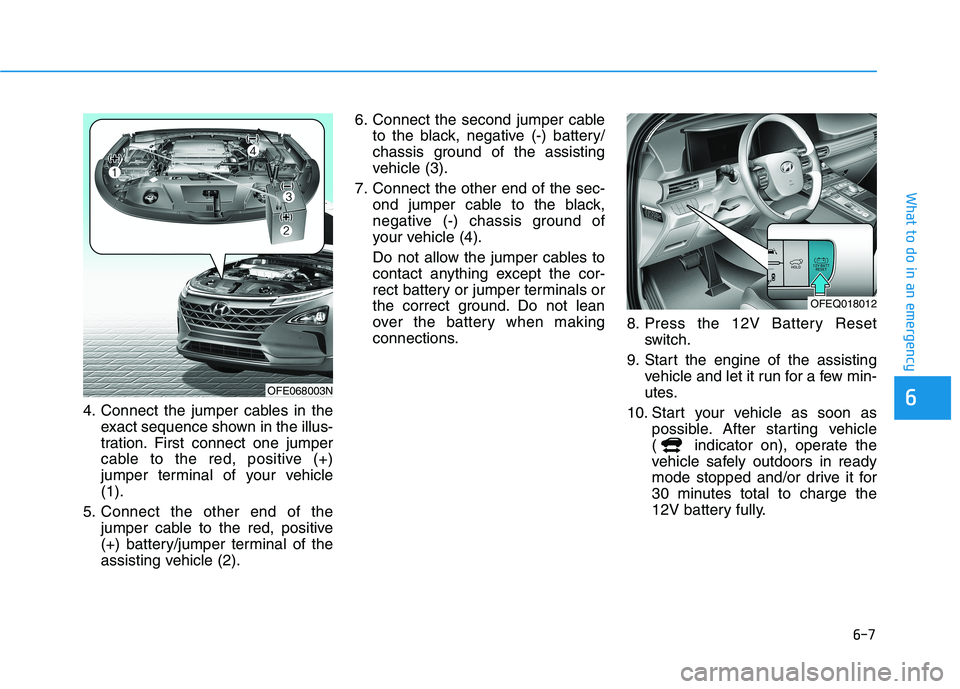
6-7
What to do in an emergency
64. Connect the jumper cables in the
exact sequence shown in the illus-
tration. First connect one jumper
cable to the red, positive (+)
jumper terminal of your vehicle
(1).
5. Connect the other end of the
jumper cable to the red, positive
(+) battery/jumper terminal of the
assisting vehicle (2).6. Connect the second jumper cable
to the black, negative (-) battery/
chassis ground of the assisting
vehicle (3).
7. Connect the other end of the sec-
ond jumper cable to the black,
negative (-) chassis ground of
your vehicle (4).
Do not allow the jumper cables to
contact anything except the cor-
rect battery or jumper terminals or
the correct ground. Do not lean
over the battery when making
connections.8. Press the 12V Battery Reset
switch.
9. Start the engine of the assisting
vehicle and let it run for a few min-
utes.
10. Start your vehicle as soon as
possible. After starting vehicle
( indicator on), operate the
vehicle safely outdoors in ready
mode stopped and/or drive it for
30 minutes total to charge the
12V battery fully.
OFE068003N
OFEQ018012
Page 465 of 561
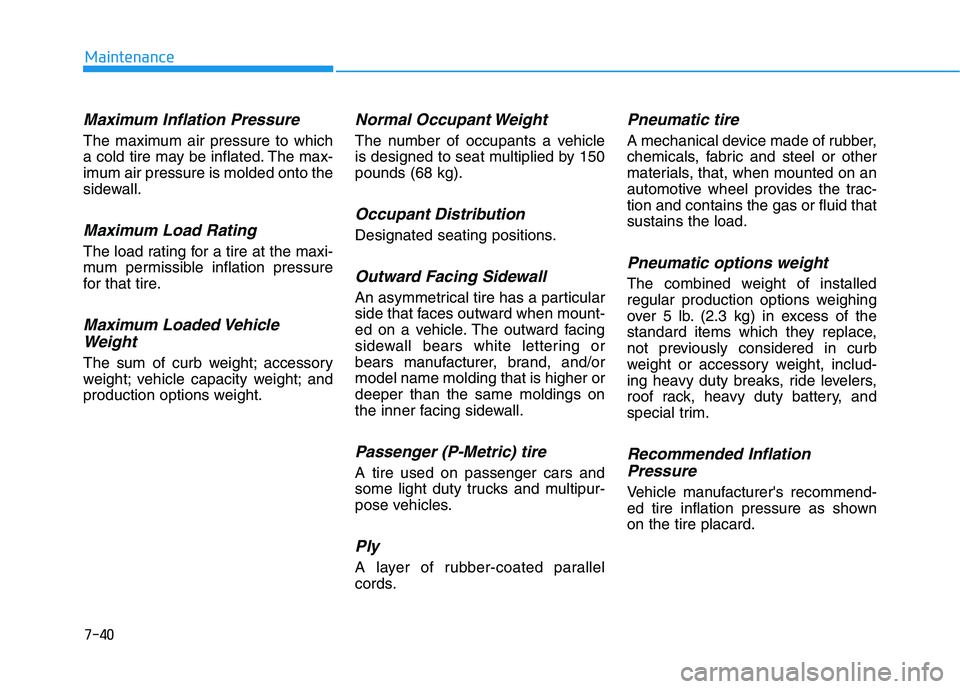
7-40
Maintenance
Maximum Inflation Pressure
The maximum air pressure to which
a cold tire may be inflated. The max-
imum air pressure is molded onto the
sidewall.
Maximum Load Rating
The load rating for a tire at the maxi-
mum permissible inflation pressure
for that tire.
Maximum Loaded VehicleWeight
The sum of curb weight; accessory
weight; vehicle capacity weight; and
production options weight.
Normal Occupant Weight
The number of occupants a vehicle
is designed to seat multiplied by 150
pounds (68 kg).
Occupant Distribution
Designated seating positions.
Outward Facing Sidewall
An asymmetrical tire has a particular
side that faces outward when mount-
ed on a vehicle. The outward facing
sidewall bears white lettering or
bears manufacturer, brand, and/or
model name molding that is higher or
deeper than the same moldings on
the inner facing sidewall.
Passenger (P-Metric) tire
A tire used on passenger cars and
some light duty trucks and multipur-
pose vehicles.
Ply
A layer of rubber-coated parallel
cords.
Pneumatic tire
A mechanical device made of rubber,
chemicals, fabric and steel or other
materials, that, when mounted on an
automotive wheel provides the trac-
tion and contains the gas or fluid that
sustains the load.
Pneumatic options weight
The combined weight of installed
regular production options weighing
over 5 lb. (2.3 kg) in excess of the
standard items which they replace,
not previously considered in curb
weight or accessory weight, includ-
ing heavy duty breaks, ride levelers,
roof rack, heavy duty battery, and
special trim.
Recommended InflationPressure
Vehicle manufacturer's recommend-
ed tire inflation pressure as shown
on the tire placard.
Page 467 of 561
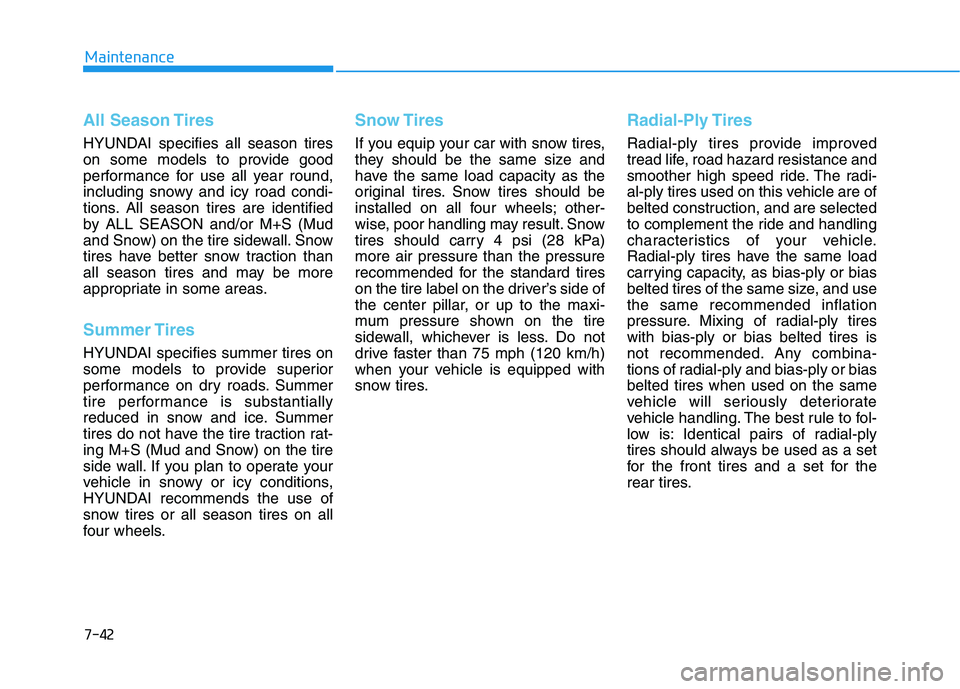
7-42
Maintenance
All Season Tires
HYUNDAI specifies all season tires
on some models to provide good
performance for use all year round,
including snowy and icy road condi-
tions. All season tires are identified
by ALL SEASON and/or M+S (Mud
and Snow) on the tire sidewall. Snow
tires have better snow traction than
all season tires and may be more
appropriate in some areas.
Summer Tires
HYUNDAI specifies summer tires on
some models to provide superior
performance on dry roads. Summer
tire performance is substantially
reduced in snow and ice. Summer
tires do not have the tire traction rat-
ing M+S (Mud and Snow) on the tire
side wall. If you plan to operate your
vehicle in snowy or icy conditions,
HYUNDAI recommends the use of
snow tires or all season tires on all
four wheels.
Snow Tires
If you equip your car with snow tires,
they should be the same size and
have the same load capacity as the
original tires. Snow tires should be
installed on all four wheels; other-
wise, poor handling may result. Snow
tires should carry 4 psi (28 kPa)
more air pressure than the pressure
recommended for the standard tires
on the tire label on the driver’s side of
the center pillar, or up to the maxi-
mum pressure shown on the tire
sidewall, whichever is less. Do not
drive faster than 75 mph (120 km/h)
when your vehicle is equipped with
snow tires.
Radial-Ply Tires
Radial-ply tires provide improved
tread life, road hazard resistance and
smoother high speed ride. The radi-
al-ply tires used on this vehicle are of
belted construction, and are selected
to complement the ride and handling
characteristics of your vehicle.
Radial-ply tires have the same load
carrying capacity, as bias-ply or bias
belted tires of the same size, and use
the same recommended inflation
pressure. Mixing of radial-ply tires
with bias-ply or bias belted tires is
not recommended. Any combina-
tions of radial-ply and bias-ply or bias
belted tires when used on the same
vehicle will seriously deteriorate
vehicle handling. The best rule to fol-
low is: Identical pairs of radial-ply
tires should always be used as a set
for the front tires and a set for the
rear tires.
Page 511 of 561
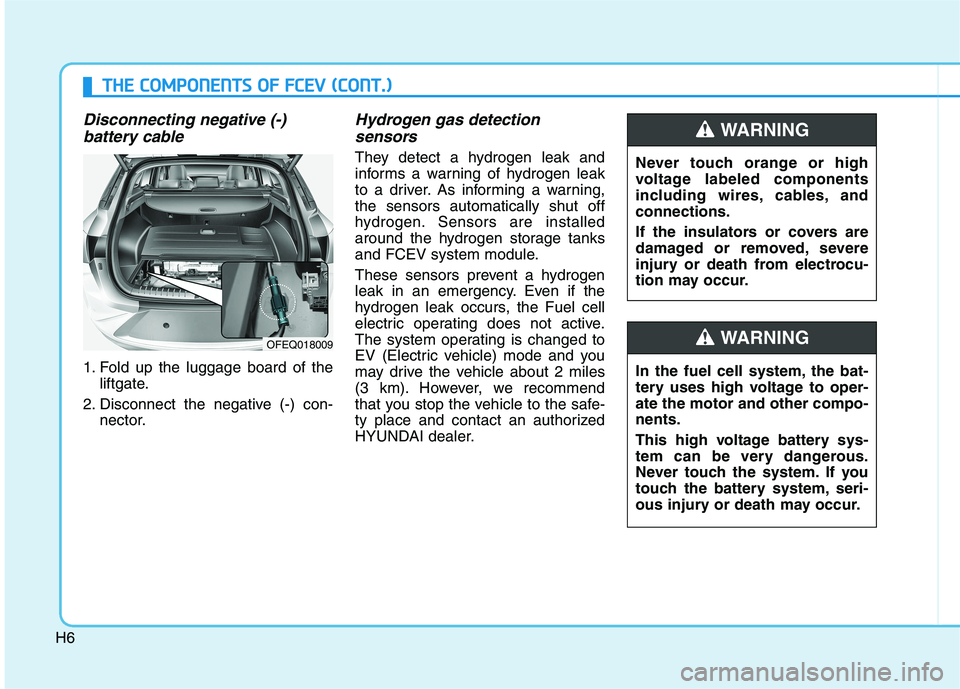
H6
Disconnecting negative (-)
battery cable
1. Fold up the luggage board of the
liftgate.
2. Disconnect the negative (-) con-
nector.
Hydrogen gas detection
sensors
They detect a hydrogen leak and
informs a warning of hydrogen leak
to a driver. As informing a warning,
the sensors automatically shut off
hydrogen. Sensors are installed
around the hydrogen storage tanks
and FCEV system module.
These sensors prevent a hydrogen
leak in an emergency. Even if the
hydrogen leak occurs, the Fuel cell
electric operating does not active.
The system operating is changed to
EV (Electric vehicle) mode and you
may drive the vehicle about 2 miles
(3 km). However, we recommend
that you stop the vehicle to the safe-
ty place and contact an authorized
HYUNDAI dealer.
OFEQ018009
T TH
HE
E
C
CO
OM
MP
PO
ON
NE
EN
NT
TS
S
O
OF
F
F
FC
CE
EV
V
(
(C
CO
ON
NT
T.
.)
)
Never touch orange or high
voltage labeled components
including wires, cables, and
connections.
If the insulators or covers are
damaged or removed, severe
injury or death from electrocu-
tion may occur.
WARNING
In the fuel cell system, the bat-
tery uses high voltage to oper-
ate the motor and other compo-
nents.
This high voltage battery sys-
tem can be very dangerous.
Never touch the system. If you
touch the battery system, seri-
ous injury or death may occur.
WARNING
Page 526 of 561

H21
FCEV mode
Entering FCEV Mode
If you select the "FCEV" menu in the AVN home screen
or the "FCEV" in the menu, you can enter the FCEV
mode.
For details on FCEV Mode, refer to the navigation manu-
al that is provided separately.
FCEV Mode Menu Screen
1. Reachable Range: It shows the reachable range on the
map.
2. Fuel cell monitoring: It shows the battery information
and the power transmission flow between the compo-
nents.
3. ECO Driving: It shows the fuel efficiency information
and environmental contribution.
4. Management : It shows the status of hydrogen tank
(warning alert) and 'FCEV Route' setting.
OFEQ018017NOFEQ018019N
OFEQ018018N
Page 530 of 561
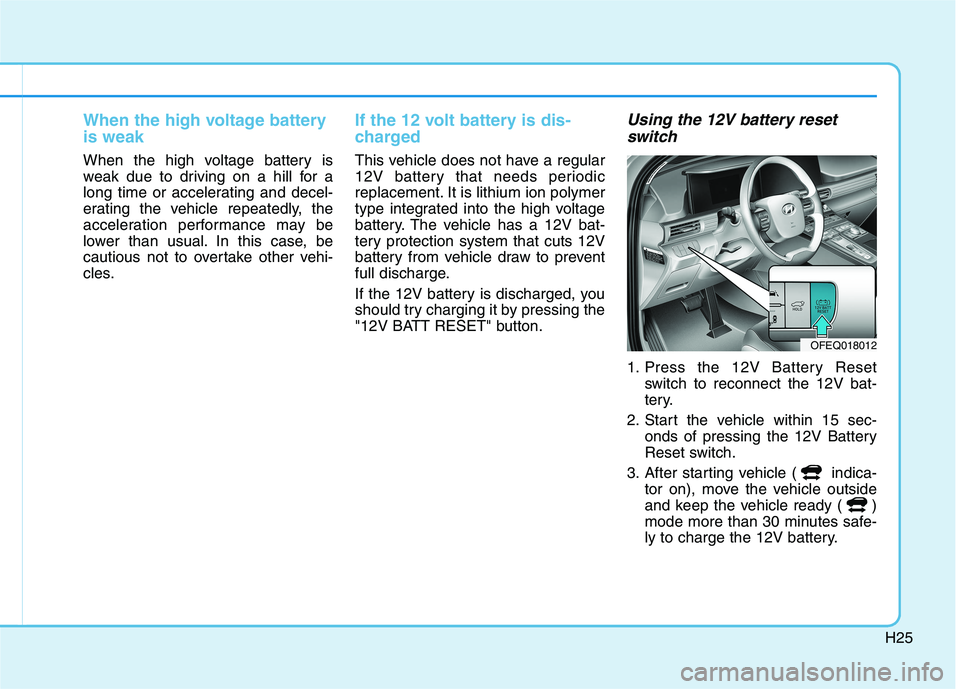
H25
When the high voltage battery
is weak
When the high voltage battery is
weak due to driving on a hill for a
long time or accelerating and decel-
erating the vehicle repeatedly, the
acceleration performance may be
lower than usual. In this case, be
cautious not to overtake other vehi-
cles.
If the 12 volt battery is dis-
charged
This vehicle does not have a regular
12V battery that needs periodic
replacement. It is lithium ion polymer
type integrated into the high voltage
battery. The vehicle has a 12V bat-
tery protection system that cuts 12V
battery from vehicle draw to prevent
full discharge.
If the 12V battery is discharged, you
should try charging it by pressing the
"12V BATT RESET" button.
Using the 12V battery reset
switch
1. Press the 12V Battery Reset
switch to reconnect the 12V bat-
tery.
2. Start the vehicle within 15 sec-
onds of pressing the 12V Battery
Reset switch.
3. After starting vehicle ( indica-
tor on), move the vehicle outside
and keep the vehicle ready ( )
mode more than 30 minutes safe-
ly to charge the 12V battery.
OFEQ018012
Page 541 of 561
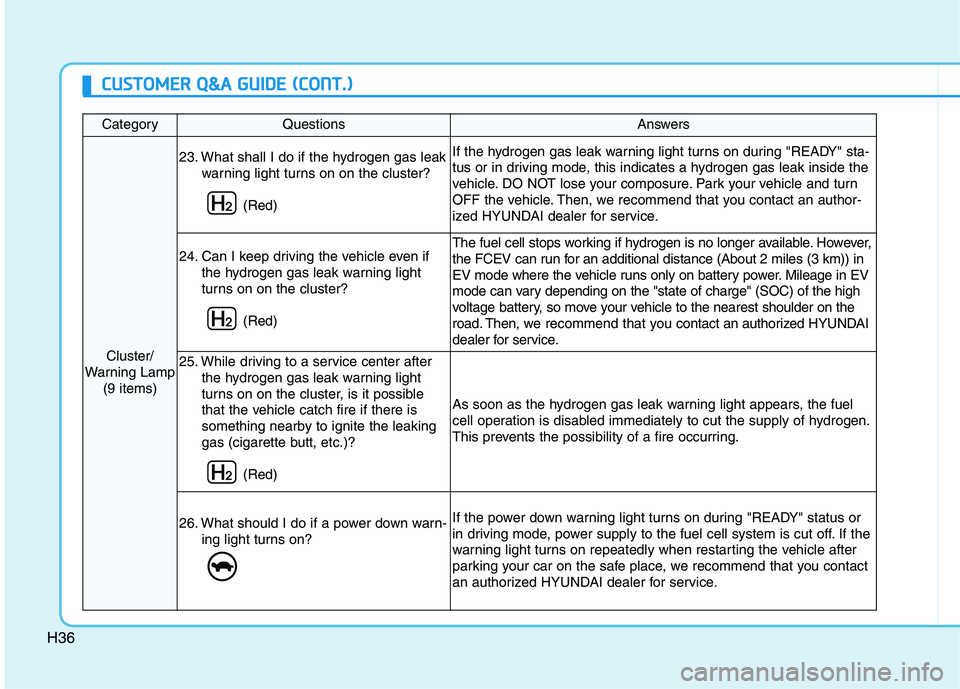
H36
CategoryQuestionsAnswers
Cluster/
Warning Lamp
(9 items)
23. What shall I do if the hydrogen gas leak
warning light turns on on the cluster?
(Red)If the hydrogen gas leak warning light turns on during "READY" sta-
tus or in driving mode, this indicates a hydrogen gas leak inside the
vehicle. DO NOT lose your composure. Park your vehicle and turn
OFF the vehicle. Then, we recommend that you contact an author-
ized HYUNDAI dealer for service.
24. Can I keep driving the vehicle even if
the hydrogen gas leak warning light
turns on on the cluster?
(Red)The fuel cell stops working if hydrogen is no longer available. However,
the FCEV can run for an additional distance (About 2 miles (3 km)) in
EV mode where the vehicle runs only on battery power. Mileage in EV
mode can vary depending on the "state of charge" (SOC) of the high
voltage battery, so move your vehicle to the nearest shoulder on the
road. Then, we recommend that you contact an authorized HYUNDAI
dealer for service.
25. While driving to a service center after
the hydrogen gas leak warning light
turns on on the cluster, is it possible
that the vehicle catch fire if there is
something nearby to ignite the leaking
gas (cigarette butt, etc.)?
(Red)
As soon as the hydrogen gas leak warning light appears, the fuel
cell operation is disabled immediately to cut the supply of hydrogen.
This prevents the possibility of a fire occurring.
26. What should I do if a power down warn-
ing light turns on?If the power down warning light turns on during "READY" status or
in driving mode, power supply to the fuel cell system is cut off. If the
warning light turns on repeatedly when restarting the vehicle after
parking your car on the safe place, we recommend that you contact
an authorized HYUNDAI dealer for service.
C CU
US
ST
TO
OM
ME
ER
R
Q
Q&
&A
A
G
GU
UI
ID
DE
E
(
(C
CO
ON
NT
T.
.)
)
Page 542 of 561

H37
CategoryQuestionsAnswers
Cluster/
Warning Lamp
(9 items)
27. What should I do if the service warning
light turns on?If the service warning light turns on during "READY" status or in
driving mode, it may indicate a malfunction in operation with any fuel
cell system. We recommend that you contact an authorized
HYUNDAI dealer for service.
28. What should I do if the master warning
light turns on?If the service warning light turns on when there is a malfuction in
operation in any of the vehicle systems. Please look at the LCD dis-
play for details and we recommend that you contact an authorized
HYUNDAI dealer for service if needed.
29. How much farther (roughly) can I drive
my FCEV when the fuel warning light
turns on? (Remaining mileage)You can continue driving for an additional 40~55 miles (70~90 km).
It may depend on driving mode.
30. When restarting the vehicle, the " "
indicator turns on on the cluster. What
does this mean?It means that the fuel cell system is working in good order and your
car is ready to drive.
31. Why does the vehicle’s hydrogen tank
have a life expectancy?
The hydrogen tank is frequently refueled with the high pressure
hydrogen gas and the number of times refueling the vehicle is limit-
ed to 5,000 times (or 15 years). The hydrogen storage system
counts the number of times the vehicle is refueled and turns on the
warning light when the vehicle is refueled for over 4,995 times.
Every time the vehicle is turned on the warning message "Replace
hydrogen tank. Maximum number of refill cycles exceeded" is dis-
played on the cluster. The vehicle can be driven about 1-3 million
kilometers until the vehicle is refueled 5,000 times, meaning that the
hydrogen tank is used semi-permanently under common driving
condition.